For a number of models I have produced resin kits under the brand name HA Models since 2018. Subjects are airplanes of Dutch designers and producers, for which no kit is avialable, and for which I could identify sufficient clients in advance to recover the production cost. These clients share the risk by ordering and paying kits prior to release. In exchange they get a discount on the commercial sales price. In total more than 550 kits have been sold.
The masters for the kits are made with the same techniques as I use for scratchbuild models, and reports on the development process can be found on this website. Up till now the following kits have been produced or are in the design or production phase.
Koolhoven F.K.43

The Koolhoven F.K.43 was a design of 1931, produced until 1938. The F.K.43 was of mixed construction with a wooden wing, covered with plywood, and a steel tube fuselage, the aft part covered with linen, the cabin part with ply and a metal sheet cowling. The F.K.43 has served satisfactorily with the KLM from 1932 to 1940 as a trainer and taxi plane and several private customers used it as a touring plane.
One aircraft, the PH-ASN, survived the war, as it escaped after the capitulation on May 15th 1940 to England and served with the R.A.F. as liaison aircraft. It has been returned to the KLM in the Netherlands in November 1945 and flew with the National Flying School in Rotterdam as PH-NAU until September 1952. It was also used by the Delft University of Technology for research in the field of boundary layers. This aircraft, registered as “965”, was also one of the two that were requisitioned by the ML (Militaire Luchtvaart, Military Air Force) prior to the war. The aircraft was scrapped in 1955.
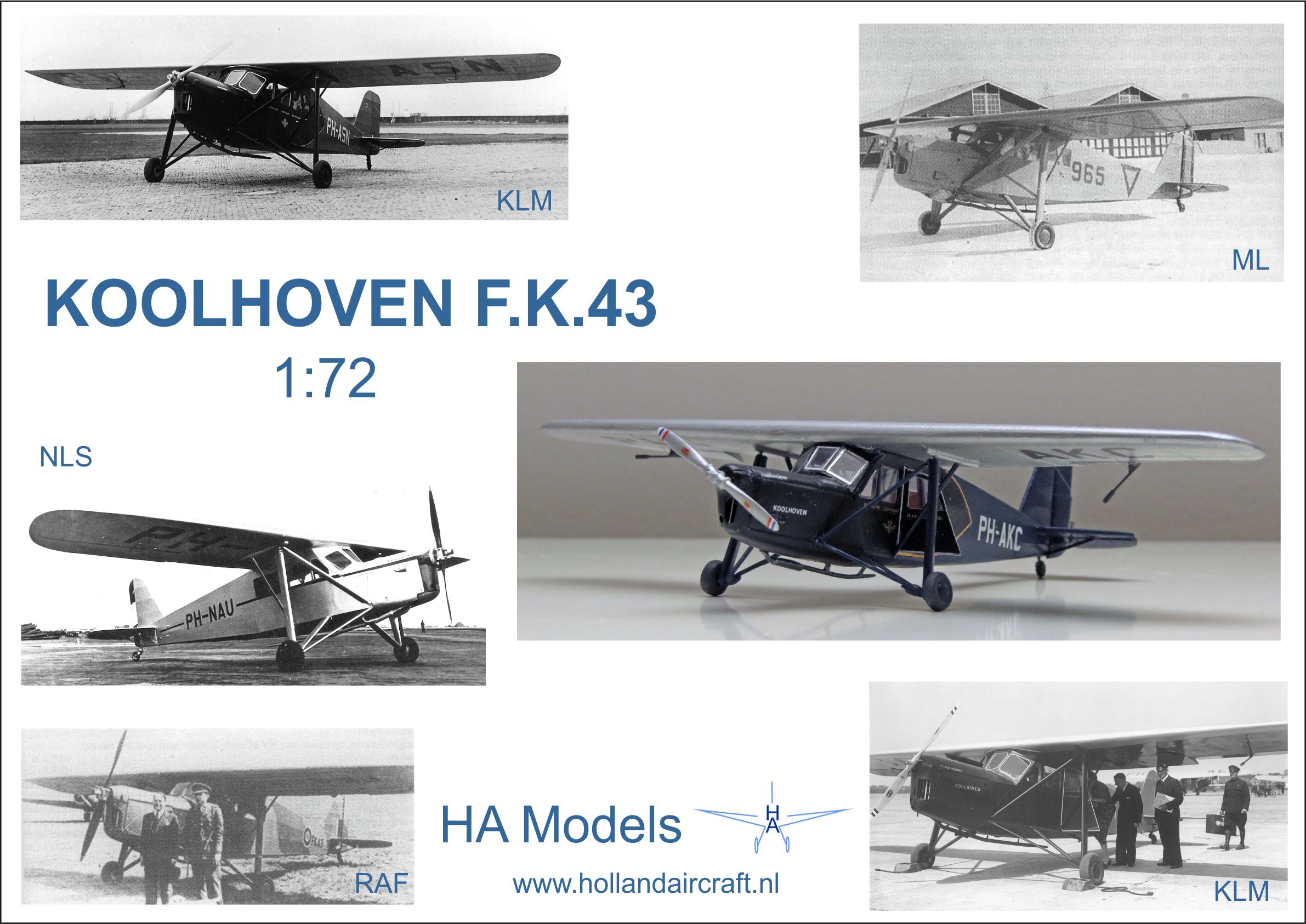
The kit contains 33 resin parts, pieces of styrene and brass rods and sheet to complete the model, a sheet of transparent plastci for the windows, several templates to facilitate the construction and of course a scale drawing and a booklet containing building instructions. Decals are included to build six different versions of the aircraft.
I have built myself the post-war NLS version, mainly to check whether the kit could be built easily. I tested the correction for an incorrectly engraved wing panel line, which I noticed too late (the moulds had already been made and production was running). A second improvement was to make the pins at the top of the main landing gear struts a couple of millimeters longer to obtain a more natural attitude of the model.
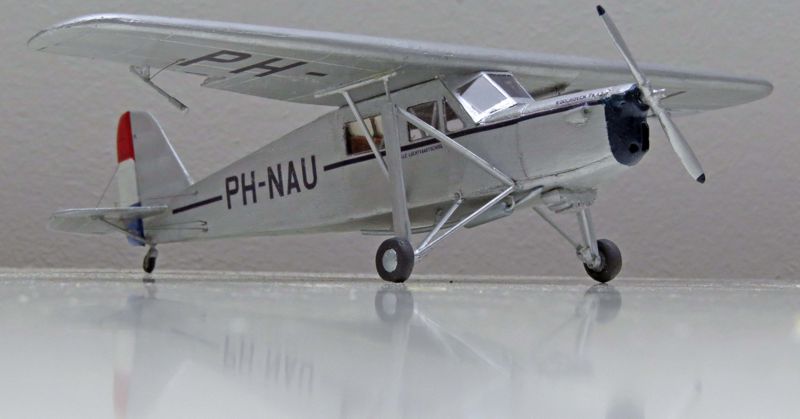
Nico Teunissen has built the Koolhoven F.K.43 in its 1939-1940 Military Air Force livery.
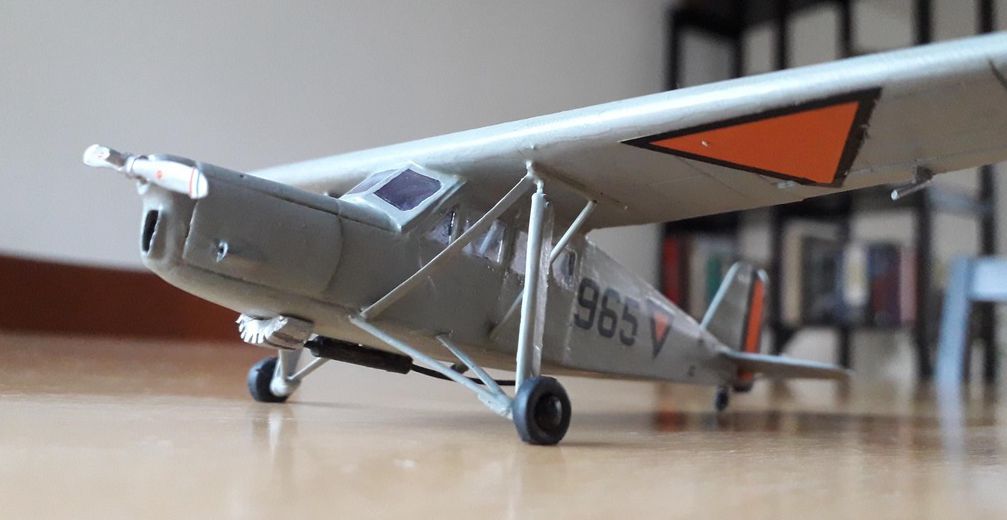
The first production run of over 50 kits was sold out in the spring of 2018. A second production run is planned for end of 2019. This will include a corrected wing panel line and updated building instructions.
Koolhoven F.K.49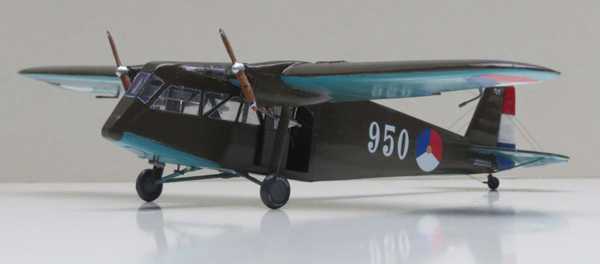
The Koolhoven F.K.49 has been developed on request of the Dutch Ordnance Survey (Topographische Dienst, TD) and the Air Service of the Dutch Army (Luchtvaartafdeling, LVA) and was operated by the LVA. The aircraft was developed in 1934-1935, motorized by two De Havilland Gipsy Major engines of 135 horsepower and was equipped with an on-board dark room. It had dual controls, so it could also be used for training. It accommodated a crew of four, a pilot, a navigator or second pilot, a photographer and an assistant photographer. The aircraft with a very characteristic angular forward fuselage was bought by the LVA, made its first flight on September 22, 1935 and was registered as 950. It was used for reconnaissance and photography missions by the LVA and was operated against direct operational cost by the LVA for the Ordnance Survey for cartography missions. It has been scrapped after the German occupation of the Netherlands in 1940.
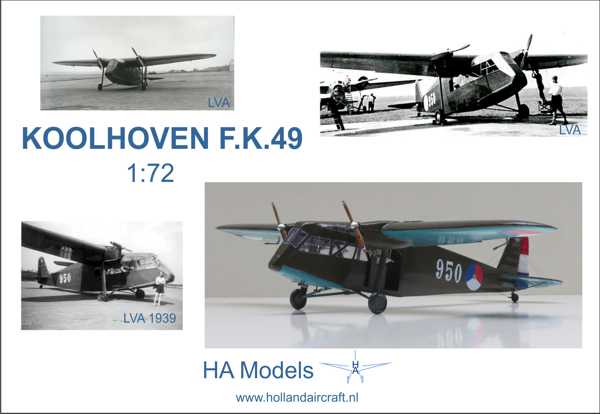
The kit contains 58 resin parts and one vacform clear plastic part, pieces of styrene and brass rods and a piece of styrene sheet to complete the model, a sheet of transparent plastic for the windows, several templates to facilitate the construction and of course a scale drawings and a booklet containing building instructions. Decals are included to build two different versions of the aircraft as it has flown with the LVA prior and after September 1939.
I have built the prototype to establish the best assembly order and to generate the picture for the instruction sheet. The kit has been released in March 2019, and has been produced in over 70 copies.
Koolhoven F.K.49A
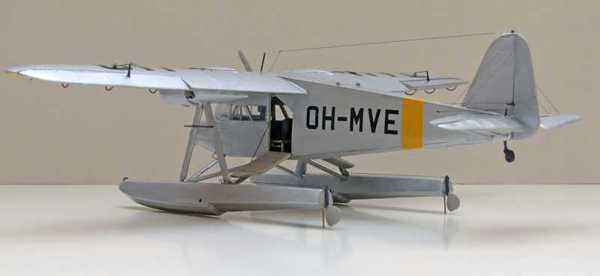
The F.K.49 has been developed in three versions with more powerful engines, which were assigned the designation F.K.49A. The second one, an ambulance aircraft for the Finnish Coast Guard with Hirth 508C engines of 285 hp, it the subject of this kit. It accommodated five people: the pilot, a radio-operator, a nurse and two patients on stretchers. The aircraft could be equipped with a wheel or (EDO) float landing gear and made its first flight on November 3, 1939. It has flown for some time in the Netherlands with floats and orange triangles under the military registration 1001 before it has been delivered to Finland in January 1940.
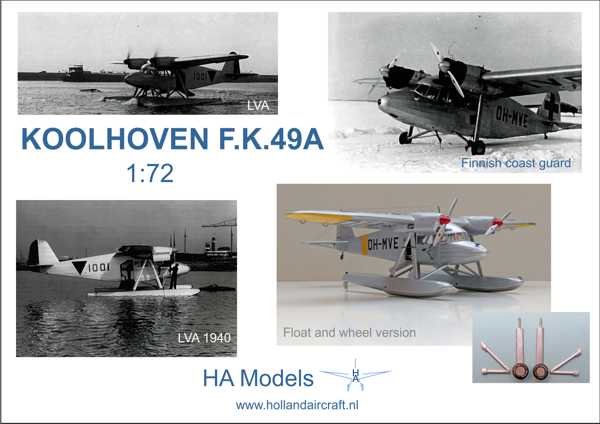
The kit contains 52 resin parts and one vacform clear plastic part, pieces of styrene and brass rods and a piece of styrene to complete the model, a sheet of transparent plastic for the windows, several templates to facilitate the construction and of course scale drawings and a booklet containing building instructions. It allows to build a version with wheel undercarriage and a version on floats. Decals are included to build two different versions of the aircraft as it has flown with the LVA (Air Department of the Dutch Army) and with the Finnish coast guard.
The kit has been released in August 2019, and has been produced in 55 copies.
Trompenburg-Spyker V.2
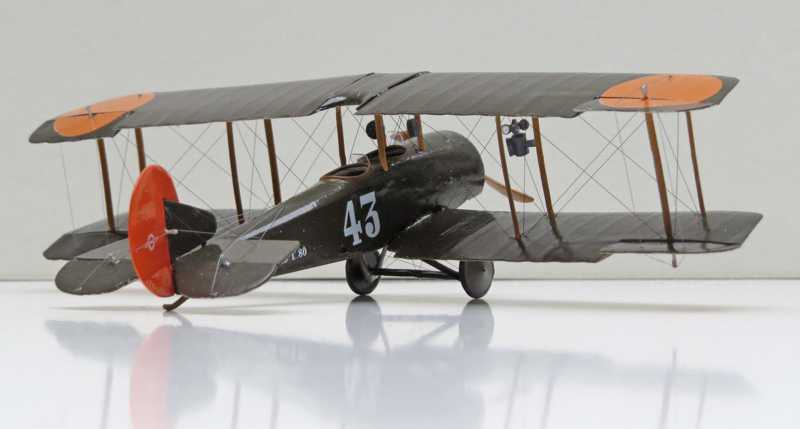
The Spyker V.2 was the first military trainer designed and produced in the Netherlands. It was developed for the Dutch navy and the Air Department of the Dutch army in 1917-1918. The design borrowed heavily from the Sopwith 1 1/2 Strutter. 78 aircraft were produced and the V.2 remained in service until 1925.
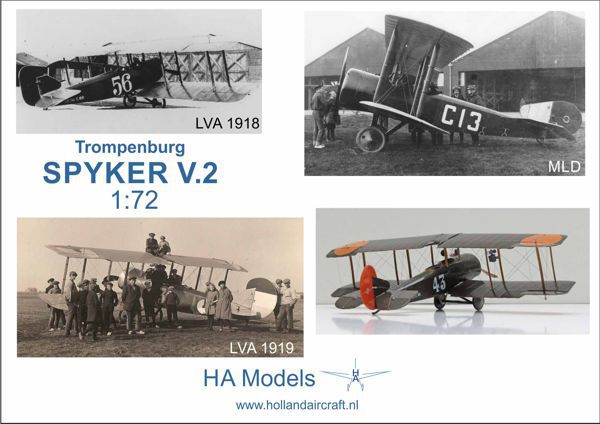
The kit contains 50 resin parts, a piece of clear plastic part for the windscreens, pieces of styrene and brass rods and a piece of styrene to complete the model, several templates to facilitate the construction and of course scale drawings and a booklet containing building instructions. It allows to build versions with three different vertical tail planes. Decals are included to build seven different versions of the aircraft as it served with the LVA and the MLD. The kit will be released in March 2020, and has been produced in 51 copies.
Fokker S.IIa
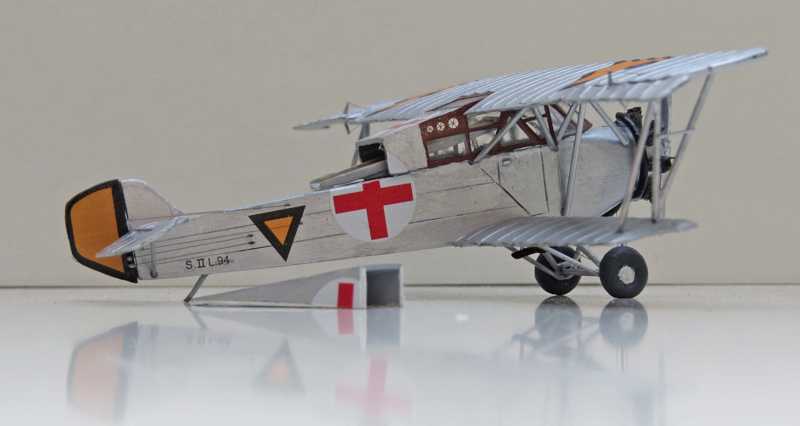
The Fokker S.IIa ambulance plane was a conversion of the Fokker S.II trainer, designed and constructed by the LVA (Dutch Army Air Department). It accommodated the pilot, a nurse and one patient on a stretcher. The first flight took place in February 1932 and the aircraft served untill May 1040. In that period it was used rather intensively, especially for the transport of patients requiring fast medical assistance or when the weather prevented other transport to the islands in the north and the middle of the Netherlands. It finally fell into the hands of the German occupation forces and disappeared without trace.
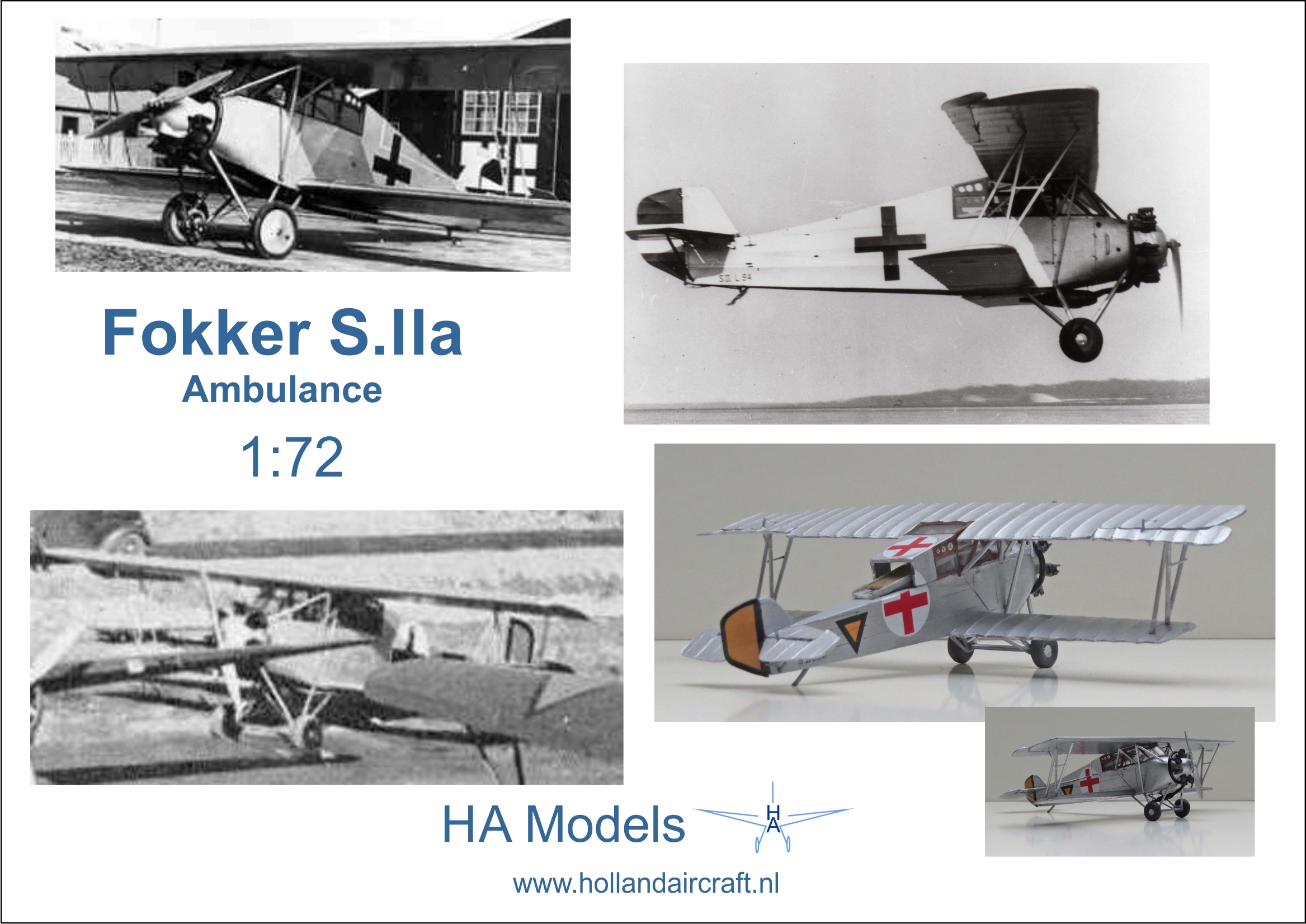
Jan Holwerda has built the S.IIa as it served the isle Schiermonikoog in the North of the Netherlands on its first flight for emergency transport to the hospital in Groningen on December 8th 1933. It completed his collection of aircraft that provided this service during the years up till now.

Q.E.D. the yacht of Tony Fokker
An usual subject for this site, but nevertheless a Fokker design. The yacht was designed and constructed in 1938 in the USA and incorporated many aircraft construction techniques and materials. A fire destroyed it in 1939 and the ship sank.
The project is a special one for the descendants of the Fokker family and the group of Fokker enthousiasts, that regularly visits the traces Fokker left in history.
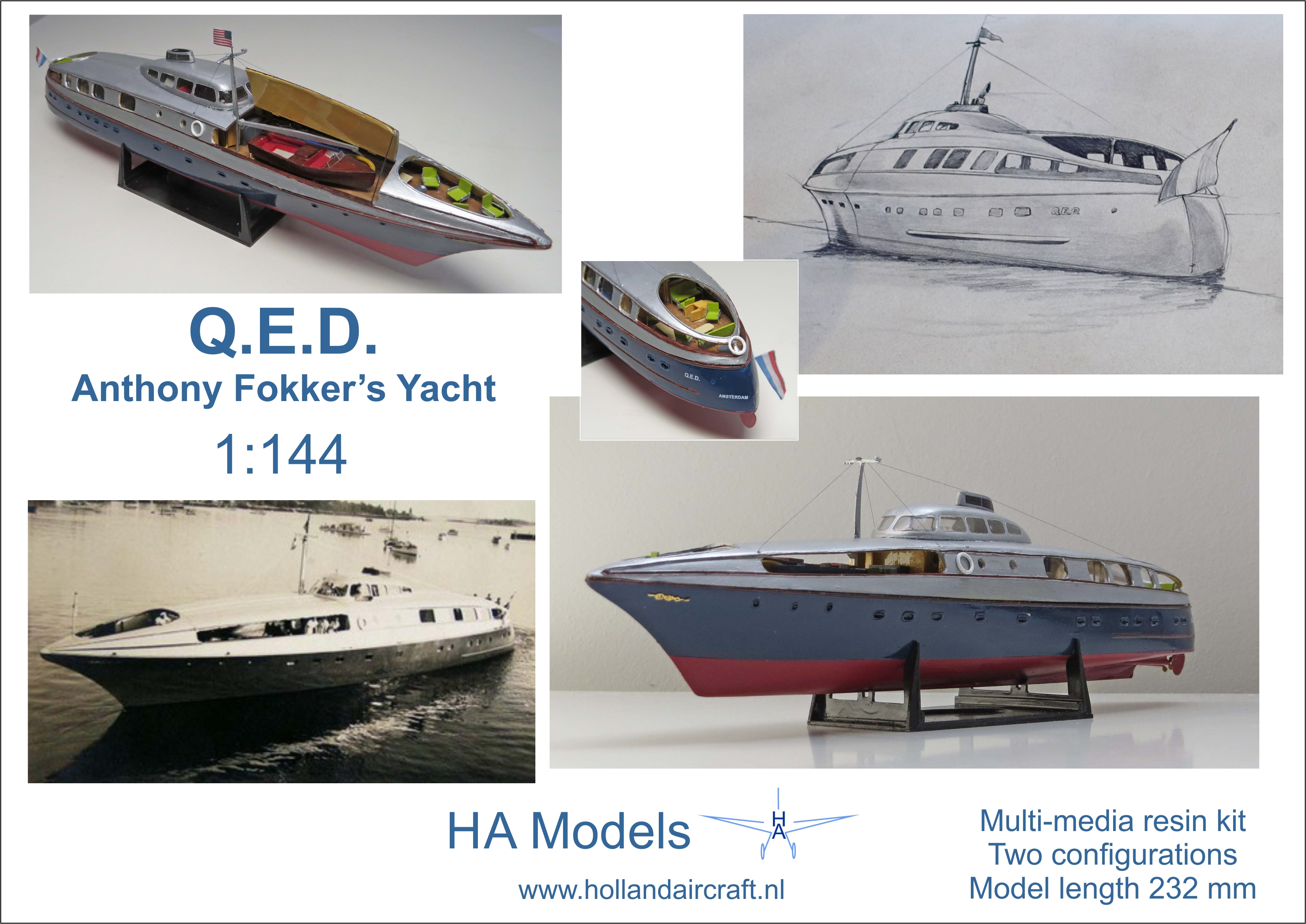
The kit contains 45 resin parts, a transparent canopy, photo-etched parts for the the small components, paint masks and an instruuction booklet. A limited number of kits is still avaiable at the Aviation Megastore and at Naval Models.
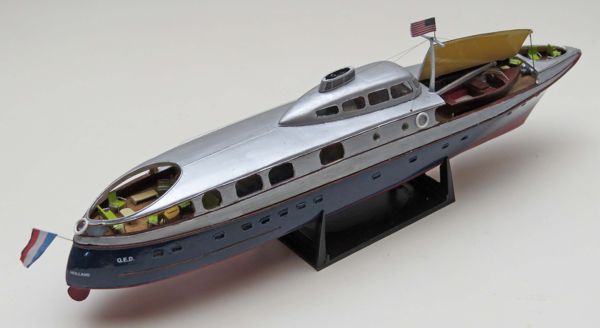
De Schelde S.20
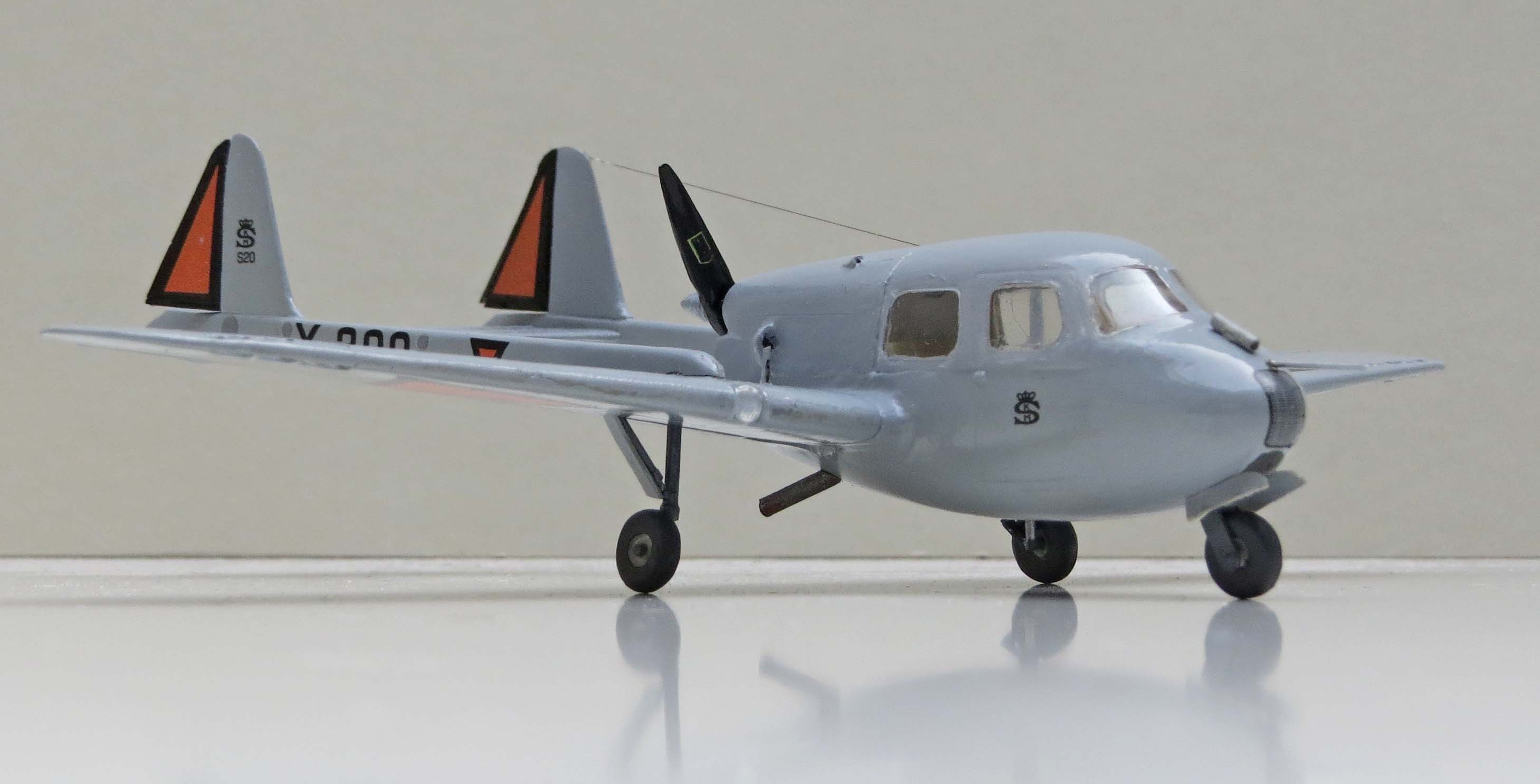
The De Schelde S.20 was designed by Slot for the De Schelde shipwarf, which had a small aviation department. It was a foour seater sports and training aircarft with dual controls. The S.20 first flew on March 29th 1940 and until May 1940 flight tests were performed, during which the undercarriage and engine cooling configuration of the plane was frequently changed. What happened to the aircaft during the German occupation is unknown. The S.20 had a nosewheel, a retractable undercarriage, dual tail booms and a pusher propeller. The wooden wing had flaps on the inner wing and fixed Handley Page slots at the wing tips to prevent early tip stalling. The tail booms were made from aluminium, as was the fuselage, which was however not a stressed skin construction, but metal panels mounted on rather sturdy frame profiles. The engine was a 160 hp air cooled Hirth HM 506A with six hanging cylinders in line.
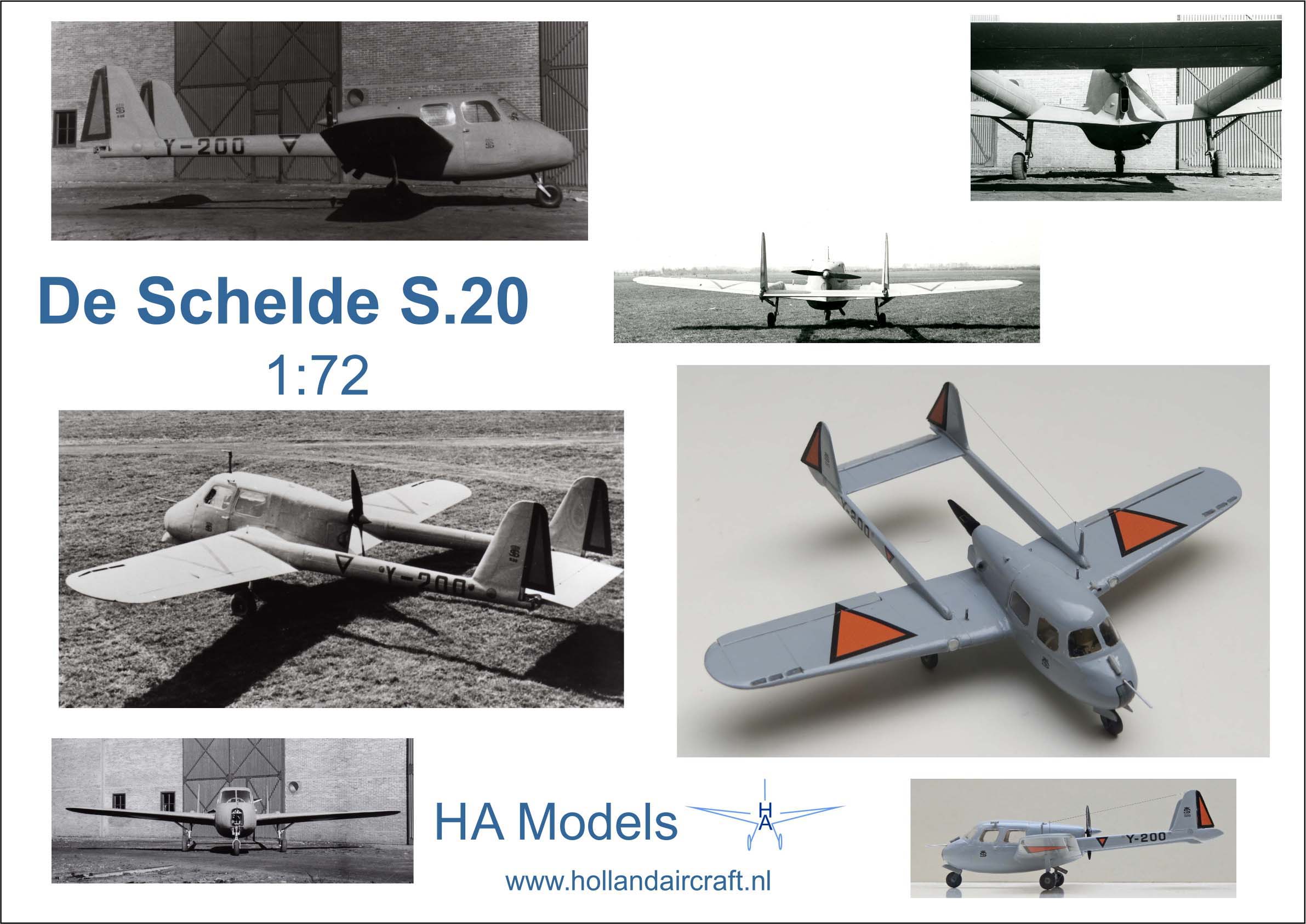
Koolhoven F.K.46S
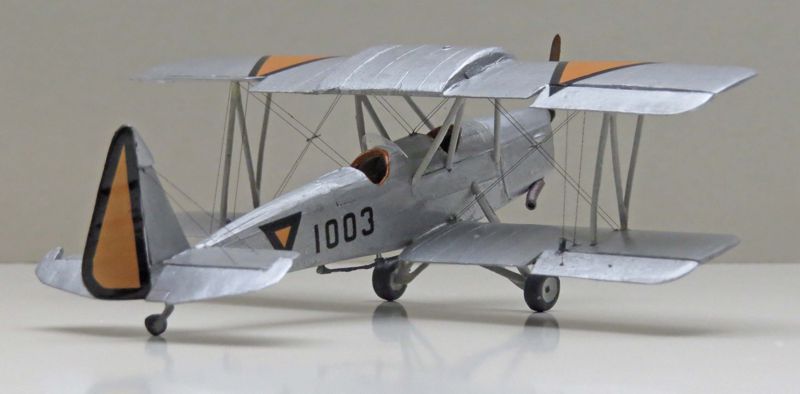
The two seat Koolhoven F.K.20S was an aerobatic version of the standard F.K.46 trainer, extensively used by the Nationale Luchtvaart School (NLS, National Flying School) in the Netherlands in the 1930's. It also flew with the Dutch Army Air Department (LVA). The aerobatic version made its maden flight in February 1937. It was demonstrated for and tested by the LVA, but not ordered. This aircraft finally ended up in the Dutch East Indies. After some improvements two aircraft were ordered by the NLS and used extensively for training. A fourth copy was demonstrated in South Africa and was requisitioned by the South African Air Force. The last copy, represented in the picture above, was requisitioned bij the LVA, at that time renamed Militaire Luchtvaart (ML, Military Air Force) and flew with orange triangles in 1939-1940.
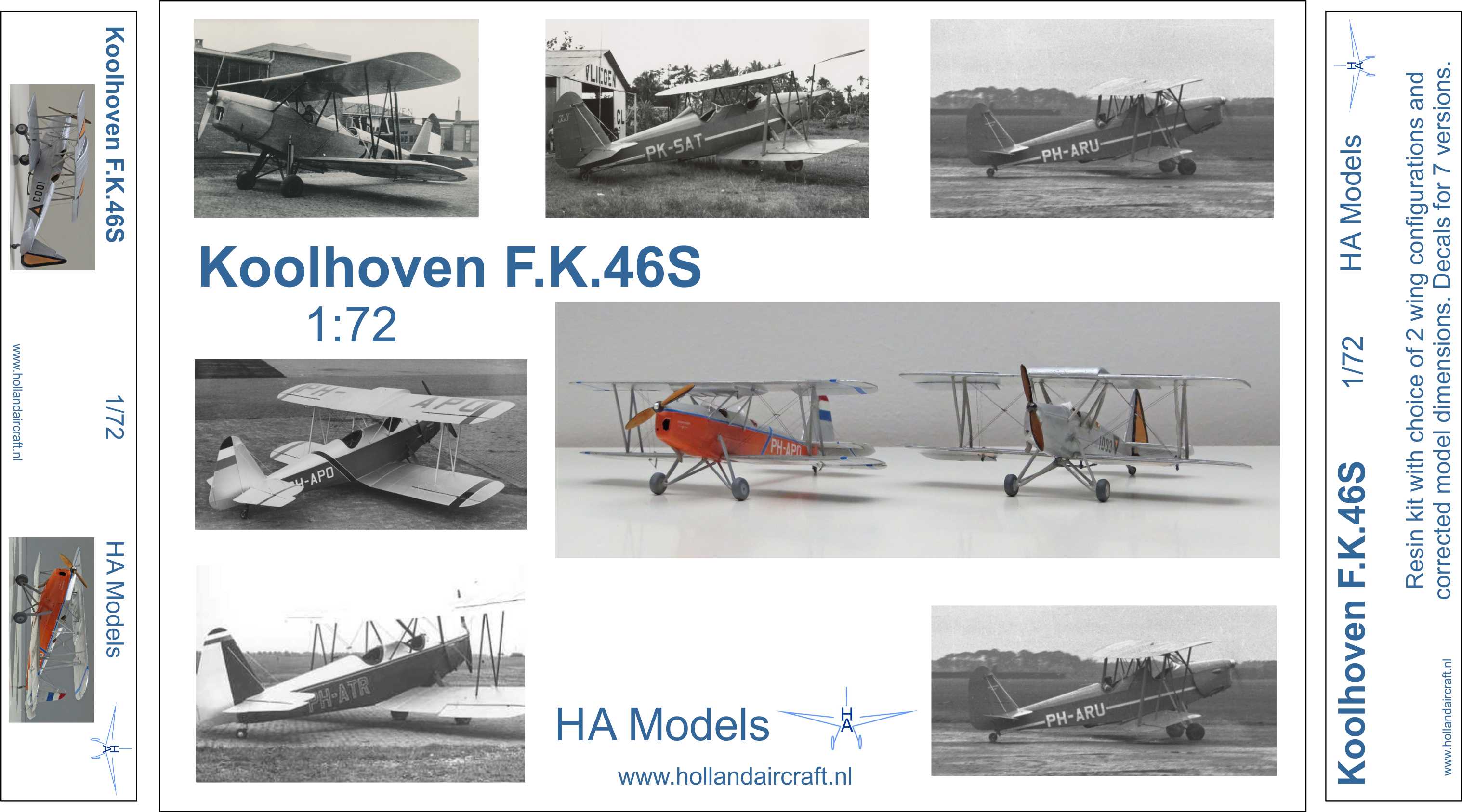
Pander E
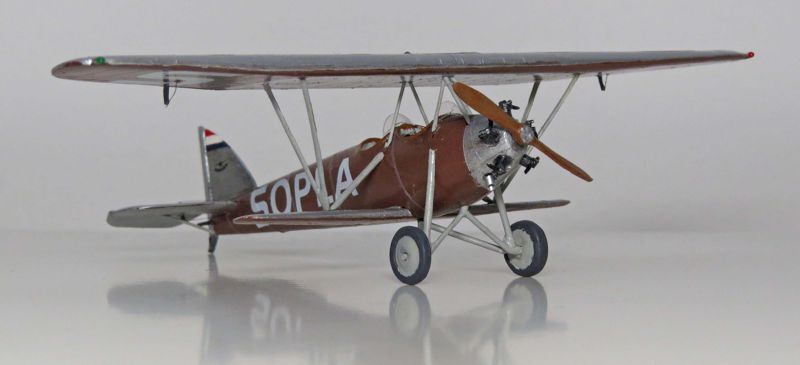
The Pander E was a two seat sequiplane, specifically designed for basic training. It first flew in February 1926 and was ordered in by the Rotterdamsche Aero Club (RAC), the first of its kind in the Netherlands, as a training and touring aircraft. Quite soon afterwards the aircraft were transfered to the Nationale Luchtvaart School (NLS, National Flying School), 100% owned bij the RAC. There it became the standard training aircraft until the arrival of the Koolhoven F.K.46 in the early 1930's. In addition the aircraft were being used as touring plane by RAC members.
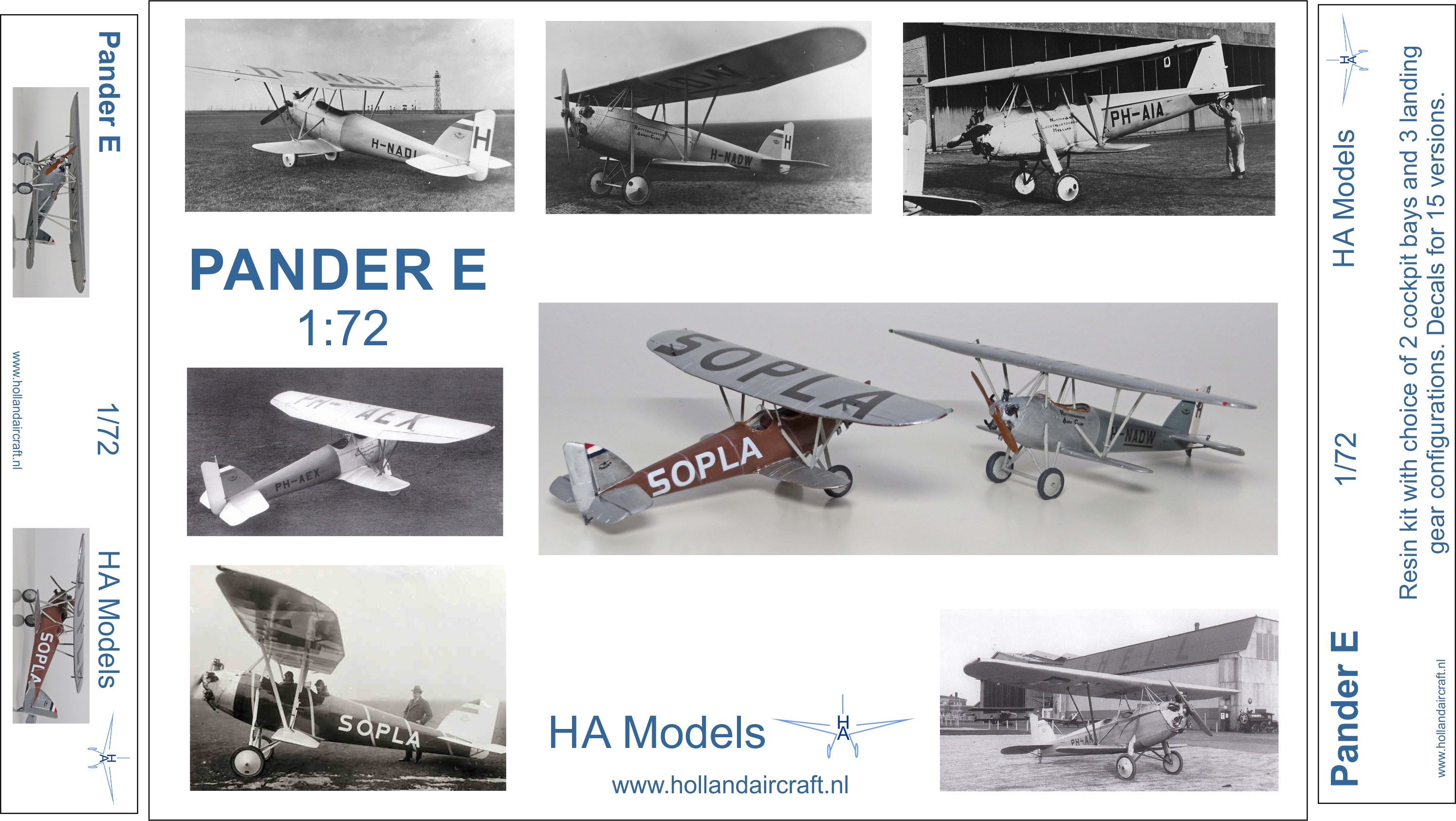
Koolhoven F.K.55 first prototype
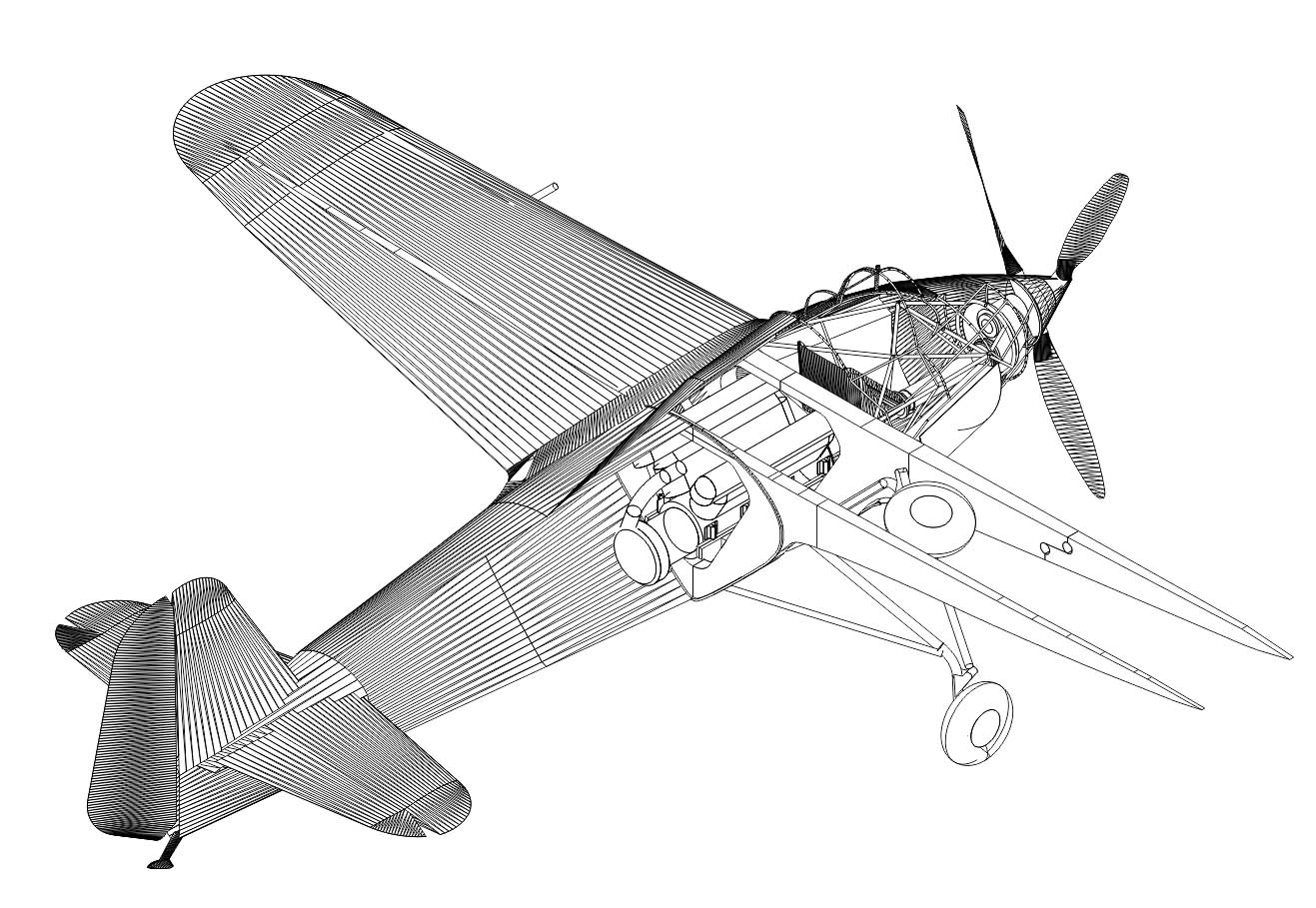
Other kits or parts
I have produced some items for my "normal" scale models, which have been issued as separate kits or parts or as parts of kits marketed by others.
Fokker 60 propellers.
For my 1/144 Fokker 60 model I have bought 3D printed propellers with blades in feathered position, as they were always in this position when the aircraft was on the ground. A set of these propellers has been casted in resin and are for sale at the Aviation Megastore. Thanks to the use of a special resin the blades are also much thinner than those in the original kit.
KLM Fokker F.VIIa decals
For the 1/72 Fokker F.VIIa kit of AB Models I have drawn decals for the aircraft in service with KLM, starting from the decals for my F.VIIa model modified from the Novoexport F.VIIb/3m kit. The decals have been printed by Arctic Models and have been included in a special issue of the kit by the Aviation Megastore.
Dollies for the MPM Fokker T.VIII-w model
I have made dollies for my own 1/72 Fokker T.VIII-w model of MPM and have produced masters for resin copies of them. They will be produced by Tilly Models.
Fokker S.13 Universal Trainer propellers, cowlings and decals
A set of decals for the civilian red and white PH-NEI livery. And a set of corrected prpellers and cowlings. Available at the Aviation Megastore.
Fokker T.IX decals
A set of corrected decals for the T.IX orange trangles. Available at the Aviation Megastore.
Building instructions
The following buiding instrutions can be downloaded from this site:
- Koolhoven F.K.43
- Koolhoven F.K.49
- Koolhoven F.K.49A
- Trompenburg-Spyker V.2
- Fokker S.IIa
- Fokker's yacht the Q.E.D.
- De Schelde S.20
- Koolhoven F.K.46S
- Pander E
The kits are for sale at the Aviation Megastore (Luchtvaart Hobby Shop) close to Schiphol Airport, as far as they are still available.
Home